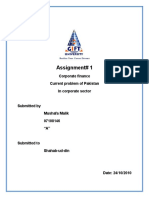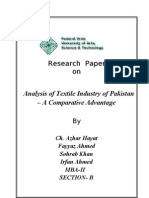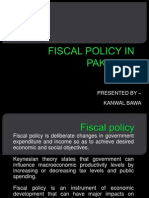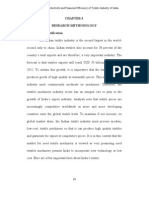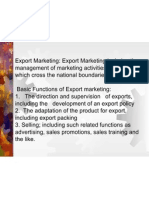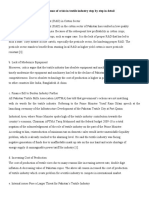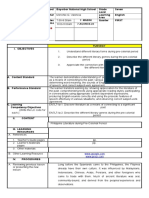Pest Analysis For Textile Industry
Pest Analysis For Textile Industry
Uploaded by
Adil MalikCopyright:
Available Formats
Pest Analysis For Textile Industry
Pest Analysis For Textile Industry
Uploaded by
Adil MalikOriginal Description:
Original Title
Copyright
Available Formats
Share this document
Did you find this document useful?
Is this content inappropriate?
Copyright:
Available Formats
Pest Analysis For Textile Industry
Pest Analysis For Textile Industry
Uploaded by
Adil MalikCopyright:
Available Formats
PEST Analysis Of Textile Sector In Pakistan
PEST Analysis: A PEST analysis is an analysis of the external macro-environment that affects all
firms. P.E.S.T. is an abbreviation for the Political, Economic, Social, and Technological factors of the external macro-environment. Such external factors usually are beyond the firm's control and sometimes present themselves as threats. For this reason, some say that "PEST" is an appropriate term for these factors. Many macro-environmental factors are country-specific and a PEST analysis will need to be performed for all countries of interest. The following are examples of some of the factors that might be considered in a PEST analysis. Political Economic Social Technological
1. Political Analysis:When a new government comes it make its own policies related to export and import of textile goods .Overnight changes in government effect investors a lot and they dont want to invest in Pakistan . Only speculators invest if they think that they can be benefited . Long time investors are not willing to invest in Pakistan. Pakistani Textile Industry is confronted with problems of different nature. The political situation of Pakistan is not satisfactory. Due to the rapid change in the Government. every government sets its own new trade policies. Govt. should apply sustainable policies for the beneficial of the exporters as well as the investors . Marshal law is always being threat to our industry. Poor law and order situation is a serious threat for Pakistan textile industry. Changing tax rates are also effecting our textile sector. Import and export restrictions is barrier for the development of textile sector. Ministry of textile industry in collaboration with Department of Textile Engineering & Technology and University of the Punjab & Textile Testing International (TTI) is offering short course on THE ROLE OF TEXTILE TESTING IN ACHIEVING QUALITY AND CONFORMANCE to comply with the global import regulations. Hike in the tariff of electricity & gas cause an increase in production cost which cuts down the demand for Pakistani textile goods in international market due to high cost of inputs. In order to survive the industry government should make electricity & gas cost cheaper. Government these days cannot coop up with the energy crisis in Pakistan. Government should try to remove the energy crisis in order to save the industry. As the crisis in energy sector cut down the production. By the reduction of production exports are also decreased .
Energy crisis: Electricity crisis:As a consequence of load shedding the textile production capacity of various sub-sectors has been reduced by up to 30 per cent. The representatives of the all textile associations presented their serious concerns on the huge losses being incurred due to electricity load shedding and the instant rise in the Electricity tariff. They said that the industry has already been crippled due to record load shedding during winter months. Gas Shortage:Gas load-shedding continues in Punjab and NWFP despite a significant increase In temperature. A spokesman for the All Pakistan Textile Mills Association claimed that 60 to 70 per cent of the industry had been affected and was unable to accept export orders coming in from around the globe. He said the textile industry had already endured over 45 days of gas disconnection over a period of four months, causing extraordinary production losses and badly affecting capability of the industry. In Punjab, he said, the textile industry's share was over 60 per cent, according to APTMA's study energy supply disruption only was causing an estimated loss of Rs1 billion per day. He regretted that at a time when the export-oriented industry had ready demand in terms of meeting export orders, the policy-makers failed to take prudent steps to help ensure timely execution of orders. In the larger interest of the economy and exports, he suggested, the government should ensure utility companies provide smooth electricity and gas supply to the textile industry and accord the industry top priority at this critical time.
2. Economic Analysis:Any development in the country does not restrict its effects to one or two sectors rather, the implications of any such development can be felt across multi-sector pathways. Same has been the case with Textile sector. Here, the discussion is limited to the contributions and effects of development in Textile industry to the Economic and Social spheres of the country. a. Increase in National Income Any development in the industrial sectors greatly contributes to the Gross Domestic Product of country. Currently, Textile sector alone contributes 9.5% to the GDP. Development of industrial sector means more investment, employment and production and hence, higher contribution towards GDP. b. Contribution to taxes The textile industry's overall contribution of taxes in 2011-12 is expected to reach Rs. 23.5 billion, including payments of withholding taxes and applicability of
lower rate of sales tax of 4%-6% on local supplies. Textile exports stood at $12.5 billion from July 2010 to May 2011. During the current fiscal year, the tax department collected Rs. 10.5 billion as 1.0% withholding tax. Similarly, textile industry contributed Rs. 2.5 billion at the rate of 0.25% as Export Development Fund (EDF). Break-up shows that the applicability of lower rate of 4%-6% sales tax on local supplies would contribute an additional amount of Rs. 11billion, annually, to the national exchequer. Moreover, the collection of withholding tax amounted to Rs. 10.5 billion during ongoing fiscal year. c. Economic Stability Growth in Textile sector has immensely contributed towards economic stability of the country. This sector alone employs 15 million work force of the country. Moreover, when the finished goods are domestically available, it helps keep prices down and fluctuations due to international market influences are less likely to strike populace. d. Improvement in Balance of Payments Textile industry has brought structural changes in the pattern of foreign trade of the country. Today, the Textile sector account for about US$ 10.2 billion export of the country. On one hand, this sector helps reduce import bills of textile products and on the other hand, it contributes in earning foreign exchange thereby helping towards keeping balance of payment in control. Following table presents a comparison of years 2008-09 and 2009-10 with respect to exports of different textile products. e. Agricultural Development Development in Textile sector greatly affected the agricultural development in turn. It is evident from the fact that if number of textile mills increased from 3 to 600 and spindles from about 177,000 to 805 million respectively in 1947 to 2010 then cotton bales increased from 1.1 million bales in 1947 to 10 million bales by 2010. Increased demand of cotton contributed towards better life of farmer by offering greater market for the raw material. f. Greater Employment As already mentioned, this sector employs about 15 million or 38 percent of total workforce of the country. If the employment rate is added with the upstream and downstream employment, like in agriculture or export related work opportunities due to this sector then the economic effect of this sector increased manifold. g. Collateral Industrial Development Development of one industry leads to the development and expansion of other industries. A number of industries and work opportunities are directly or
indirectly related with Textile Sector. For example, colours and dies, plastics, printing, machinery etc are equally affected by booms or busts in Textile sector. h. Enhanced Government Revenues Any industrial development is bound to increase government revenues. Though textile sector is still zero rated for the purposes of sales tax on exports yet the tax on domestic supply and income tax contribute greatly to government revenues. i. Diversification of Economy Development in textile sector has helped in diversifying economy by reducing dependence on mere production and export of raw material. It also instilled diversification by stimulating collateral industrial development.
3. Social Analysis:
Social Factors Affecting Pakistan Textile Industry:
Globalisation. Textile industry products sold in the Pakistan originate from all around the world,
often from developing countries. This global trade can lead to improved economies, and creates employment for many people - often women - providing them with financial stability and a chance to escape poverty. But the process is not perfect, with low wages, poor workers rights (inadequate health and safety, long hours, no contracts) and child labour apparent in some countries.
Workers rights/Education. Falling prices of textile products of Pakistan have put cheap production in demand all along the supply chain, from pickers and labourers on farms to factory workers. There is added pressure on producers to cut corners, and workshops with poor standards are seen as a hidden way to do this . Much of the manufacture of garments employs unskilled - or low skilled workers who lack of knowledge of rights, or are prevented from joining together in trade unions. Health and Safety. Workshops in developing countries can have less stringent restrictions through regulations than those apparent in the UK or more developed nations. Wheras in Pakistan Textile industry Where working conditions are poor, workers health can suffer (with the likes of backache, eyestrain, burns and other injuries. There are even reports of restricted allowance of toilet breaks, leaving workers with severe kidney problems ). And when long hours - up to 16 hour days in some countries - are factored in, fatigue can compound the likelihood of accidents. Animal Welfare. With materials such as wool, leather and fur, farming and handling of animals is an integral part of the production process. Poor farming practice can lead to neglect or mistreatment of animals, with malnutrition, infections and illness potential symptoms. Some countries have much less restrictive regulations to protect animal welfare, particularly in respect of transportation, slaughter and processes such as tooth-grinding and mulesing
4. Technological Analysis:Textiles consist of fibers, yarns, fabrics and finishes. Each of these stages has a variety of processes involved to reach the next stage .Technical textiles offer an excellent opportunity to contribute in economy and also a new direction, new ways and means to sustain in the near future. An average of 4% growth in technical textiles was expected during the period from 1995-2005 and almost it is gained. Some of the machineries includes in various departments of Textile Industry such as: Blow room Carding Combing Weaving Bleaching Testing Finishing now a days textile industry totally become computerized because of time and preferences changing of customer. All designs designed on computerized system first then using heavy machines product came into existence In 1990 to 2000 era when Chinese revolution not came then mostly Japanese and expensive machines used in Pakistan. There are many drawbacks and one is that the maintenance cost is much higher then its production. If there was any fault in machine then a foreign engineer is hired and calls him to come in that country and repair it. So cost increased rapidly. To maintain the quality some of the following machines introduced and used to reduce cost, time, labor and quick finishing: 1. 2. 3. 4. 5. 6. TRASH ANALYZER FIBER FINENESS TESTER FIBER BUNDLE STRENGTH TESTER ELECTRIC LEA STRENGTH TESTER MULTI COUNT BALANCE MULTI STRENGTH MEASUREMENT
You might also like
- Pestel Analysis of Textile IndustryDocument7 pagesPestel Analysis of Textile IndustryAakash Khurana0% (3)
- Pestel Analysis of Nishat MillsDocument3 pagesPestel Analysis of Nishat MillsSaad MalikNo ratings yet
- Internship Report of Leather CoordinatorsDocument19 pagesInternship Report of Leather Coordinatorswaleed ahmadNo ratings yet
- Term Paper On: Diamond Porter Analysis of Textile Industry of Pakistan - A Comparative AdvantageDocument29 pagesTerm Paper On: Diamond Porter Analysis of Textile Industry of Pakistan - A Comparative AdvantageSiidraa Tahir100% (1)
- Garments Sector in Bangladesh Past, Present & FutureDocument21 pagesGarments Sector in Bangladesh Past, Present & Futuretaijulshadin100% (2)
- Nishat SWOT AnalysisDocument7 pagesNishat SWOT Analysisshahmeerbilal71% (7)
- Installation of Cable Car SystemDocument5 pagesInstallation of Cable Car SystemRaq KhoNo ratings yet
- History of Pakistan Textile IndustryDocument9 pagesHistory of Pakistan Textile Industryadilkhalique100% (4)
- PEST of Gul AhmedDocument6 pagesPEST of Gul AhmedEemane33% (3)
- PEST AnalysisDocument5 pagesPEST AnalysisSultan HaiderNo ratings yet
- Pakistan Textile Industry Facing New ChallengesDocument11 pagesPakistan Textile Industry Facing New ChallengesAliasif666No ratings yet
- A Crisis in Textile IndustryDocument21 pagesA Crisis in Textile Industrymmtanveer78688% (8)
- BCG Matrix - NishatDocument3 pagesBCG Matrix - Nishatbakhoo12No ratings yet
- Kohinoor Textile Marketing AnalysisDocument29 pagesKohinoor Textile Marketing Analysisadeel50% (4)
- PEST AnalysisDocument7 pagesPEST Analysishassan56A33% (3)
- Fazal ClothDocument58 pagesFazal ClothHaider Sarwar100% (4)
- Api PPT Textile IndustryDocument49 pagesApi PPT Textile IndustryHuma JawaidNo ratings yet
- Porter Diamond Model Case Study IIDocument20 pagesPorter Diamond Model Case Study IIVania Shakeel100% (1)
- Analysis of Textile Industry of PakistanDocument25 pagesAnalysis of Textile Industry of PakistanGreen Crescents73% (11)
- Ch#5 Agriculture Critical IssuesDocument31 pagesCh#5 Agriculture Critical Issuesڈاکٹرعدنان يوسفزئ100% (1)
- Analysis of Textile Industry of PakistanDocument25 pagesAnalysis of Textile Industry of PakistanSumrah KhalidNo ratings yet
- NishatDocument40 pagesNishatmailk Ali100% (3)
- Bangladesh and International TradeDocument21 pagesBangladesh and International TradeFiroj AhmedNo ratings yet
- Swot Analysi1Document4 pagesSwot Analysi1ninimania1100% (1)
- Nishat Textile Mills Limited Marketing ReportDocument15 pagesNishat Textile Mills Limited Marketing Reportfarooq56No ratings yet
- The Business Environment of PakistanDocument31 pagesThe Business Environment of PakistanMoon Kazmi67% (6)
- Report On Bangladeshi Readymade Garment IndustryDocument22 pagesReport On Bangladeshi Readymade Garment IndustryHirok Rahman100% (1)
- What Is Export Management?Document2 pagesWhat Is Export Management?subbu2raj3372No ratings yet
- Kohinoor Textile MillDocument90 pagesKohinoor Textile MillSaMeia FarhatNo ratings yet
- Assignment 1 PositioningDocument6 pagesAssignment 1 PositioningSaba Tauqir Khan100% (1)
- Financial System of PakistanDocument3 pagesFinancial System of Pakistaniftikharchughtai83% (12)
- The Process of Industrialization (1947-58)Document18 pagesThe Process of Industrialization (1947-58)salman24100% (3)
- Researching Firm Level Strategy and Competitiveness' 2012Document57 pagesResearching Firm Level Strategy and Competitiveness' 2012Umer MalikNo ratings yet
- Fiscal Policy in PakistanDocument37 pagesFiscal Policy in Pakistankanwal_bawa75% (4)
- Economics ProjectDocument13 pagesEconomics ProjectvivekNo ratings yet
- Mahmood Textile Mills LTDDocument69 pagesMahmood Textile Mills LTDmuhammadtaimoorkhan100% (2)
- Nishat Textile MillsDocument24 pagesNishat Textile Millssohail0% (1)
- Pest Analysis On Textile IndustryDocument5 pagesPest Analysis On Textile IndustryReena Pal100% (1)
- Analysis of Textile IndustryDocument31 pagesAnalysis of Textile IndustryDinesh Gupta25% (4)
- Nishat Textile - Strategic Management FrameworkDocument39 pagesNishat Textile - Strategic Management FrameworkZara Imran50% (2)
- Export MarketingDocument10 pagesExport MarketingHasib JaforNo ratings yet
- SWOT Analysis On Readymade Garment Industry in BangladeshDocument3 pagesSWOT Analysis On Readymade Garment Industry in BangladeshMd.Latifull Alam100% (1)
- Service Sector of PakistanDocument2 pagesService Sector of Pakistanshahidsark100% (1)
- Macro Assignment2Document5 pagesMacro Assignment2Anonymous 2WPnoE16SNNo ratings yet
- Nishat Textile Mills (Strategic Management)Document5 pagesNishat Textile Mills (Strategic Management)flavia1286No ratings yet
- Agricultural Price Policy in PakistanDocument2 pagesAgricultural Price Policy in PakistanRohailNo ratings yet
- BCG MatrixDocument3 pagesBCG MatrixRabbiya irfan100% (2)
- PEST Analysis On The RMG Sectors in Bangladesh by Mohammad MoniruzzamanDocument3 pagesPEST Analysis On The RMG Sectors in Bangladesh by Mohammad MoniruzzamansumoniubbdNo ratings yet
- 8 INTERNSHIP REPORT MTM Textile Mill Limited MBADocument85 pages8 INTERNSHIP REPORT MTM Textile Mill Limited MBAyumna100% (1)
- Ahmad Fine Textile Mills LTDDocument83 pagesAhmad Fine Textile Mills LTDfaisalNo ratings yet
- O M 5568 End Term AssesmentDocument6 pagesO M 5568 End Term AssesmentMuhammad WaqasNo ratings yet
- Effects On Textile Industry Due To Energy CrisisDocument8 pagesEffects On Textile Industry Due To Energy Crisismudassar jamil100% (2)
- Chapter I: Introduction: Pakistani Textile - Industrial ReportDocument15 pagesChapter I: Introduction: Pakistani Textile - Industrial ReportAbsar NazirNo ratings yet
- Growth Trends of Pakistan Textile IndustryDocument8 pagesGrowth Trends of Pakistan Textile IndustryWaris ArslanNo ratings yet
- EconomyDocument8 pagesEconomyعبداللہ یاسر بلوچNo ratings yet
- Textile ReportDocument15 pagesTextile ReportSANIANo ratings yet
- API Report - Raja Omar Farooq (26728)Document11 pagesAPI Report - Raja Omar Farooq (26728)Umer FarooqNo ratings yet
- Pest Analysis of KTMDocument23 pagesPest Analysis of KTMorakzai_496_547831500% (1)
- Muhammad Danish Dar (9182024) (BBA-4C Evening) (Assignment 2)Document8 pagesMuhammad Danish Dar (9182024) (BBA-4C Evening) (Assignment 2)Danish DarNo ratings yet
- Company Profile: Nishat MillsDocument15 pagesCompany Profile: Nishat MillsSabeeh Ul HassanNo ratings yet
- The Impact of Energy Crisis On Textile SectorDocument4 pagesThe Impact of Energy Crisis On Textile SectorAymen SaeedNo ratings yet
- Topic 11 Homework AnswersDocument4 pagesTopic 11 Homework Answersiwhy_No ratings yet
- Project Planning and AcquisitionDocument14 pagesProject Planning and AcquisitionPrabesh PoudelNo ratings yet
- 3 Inherent Powers of The StateDocument1 page3 Inherent Powers of The StateCarla Abapo RCrim85% (40)
- CPD RecordExample PDFDocument2 pagesCPD RecordExample PDFRadha Krishnan RNo ratings yet
- Chartered Financial Analysts - CFADocument4 pagesChartered Financial Analysts - CFAjimeetshhNo ratings yet
- Grade 1 To 12: Daily Lesson Log Based From Deped Order No. 42, S. 2016Document3 pagesGrade 1 To 12: Daily Lesson Log Based From Deped Order No. 42, S. 2016Heidee MatiasNo ratings yet
- Risk ManagementDocument2 pagesRisk ManagementRana GaballahNo ratings yet
- Compositional Techniques and Graphic Design ApplicationDocument18 pagesCompositional Techniques and Graphic Design ApplicationbillyNo ratings yet
- 03 Market IntegrationDocument19 pages03 Market Integrationmark larkNo ratings yet
- Middle Childhood (Socio-Emotional) PDFDocument49 pagesMiddle Childhood (Socio-Emotional) PDFLee DuquiatanNo ratings yet
- Scale of ChargesDocument4 pagesScale of ChargesAshwin RajendranNo ratings yet
- Students' Involvement in Social Volunteering: C. Bacter C. MarcDocument8 pagesStudents' Involvement in Social Volunteering: C. Bacter C. MarcCorina NichiforNo ratings yet
- Beena Kannan: Submitted By, Shine S Thomas MBA Smbs MGUDocument8 pagesBeena Kannan: Submitted By, Shine S Thomas MBA Smbs MGUShine S Thomas100% (1)
- A Study On Prospects and Challenges of Mobile Banking in IndiaDocument10 pagesA Study On Prospects and Challenges of Mobile Banking in IndiaAkshay PawarNo ratings yet
- Table of Specification: Gender & SocietyDocument1 pageTable of Specification: Gender & SocietyJENNIFER YBAÑEZNo ratings yet
- 15.1opportunities and Challenges in Media and Information LecDocument21 pages15.1opportunities and Challenges in Media and Information LecBenjamin CaspilloNo ratings yet
- Engineering Drawing (Graphics) Technical DrawingDocument47 pagesEngineering Drawing (Graphics) Technical DrawingErhan TokNo ratings yet
- Chapter IIIDocument6 pagesChapter IIIHazel Norberte SurbidaNo ratings yet
- Prepare 2 Year and Unit PlansDocument75 pagesPrepare 2 Year and Unit Plansjj qqNo ratings yet
- Lesson Plan: Institución Educativa "Capitán Alfonso Arroyo Aguirre"Document3 pagesLesson Plan: Institución Educativa "Capitán Alfonso Arroyo Aguirre"Dani PerezNo ratings yet
- 39 Topics Sample Ielts Speaking Part 1Document72 pages39 Topics Sample Ielts Speaking Part 1Ngọc HuỳnhNo ratings yet
- SLC GOV ContractDocument7 pagesSLC GOV ContractEnoch SimpsonNo ratings yet
- Múgiithi Music As Social Discourse in Urban KenyaDocument17 pagesMúgiithi Music As Social Discourse in Urban KenyakiopogmailcomNo ratings yet
- Indirectness in Persuasive Messages: Chapter: EightDocument22 pagesIndirectness in Persuasive Messages: Chapter: EightSchizophrenic RakibNo ratings yet
- SEBI Circular - Resignation of AuditorDocument5 pagesSEBI Circular - Resignation of AuditorSumit KhuranaNo ratings yet
- Epa Diving Safety Manual 2016Document227 pagesEpa Diving Safety Manual 2016PatarHanifNo ratings yet
- Mr. Santillan Mid - Cov.2Document2 pagesMr. Santillan Mid - Cov.2Jezza PastorizaNo ratings yet
- Station Rotations Model Planning Template: Step 1: Reimagine The Learning EnvironmentDocument10 pagesStation Rotations Model Planning Template: Step 1: Reimagine The Learning Environmentelc schoolNo ratings yet










